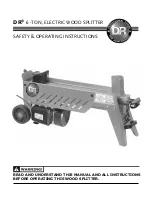
BASIC SAFETY INFORMATION
ExhAUST FUMES ARE DANGEROUS
•Never operate the engine in a closed area or it may cause uncon-
sciensness and death within a short time. Operate in a well ventilated
area.
FUEL IS hIGhLY FLAMMABLE AND POISONOUS
•Always turn off the engine when refueling.
•Never refuel while smoking or in the vicinity of an open flame.
•When operating or transporting engine and log splitter, be sure to
keep it upright. If it tilts, fuel may leak from the carburetor or fuel tank.
ENGINE AND MUFFLER MAY BE hOT
•Place the engine/log splitter in an appropriate location, away from chil-
dren and pedestrians.
•Avoid placing any flammable materials near the exhaust outlet during
operation.
•Keep a 4ft. clearance from buildings or other equipment around the
engine/log splitter to prevent overheating.
wARNING!
The engine muffler will be very hot after use, avoid touch-
ing the engine or muffler while they are still hot.
ELECTRIC ShOCK PREvENTION
•Never operate in rain or snow.
•Never touch the engine with wet hands or electric shock could occur.
FUEL
Make sure there is sufficient fuel in the tank.
SPECIFIC SAFETY INFORMATION
TAMPERING wITh FACTORY SET ENGINE SPEED SETTINGS.
Engine speed has been factory set to provide safe operation. Tamper-
ing with the engine speed adjustment could result in over-heating and
could cause a fire. Never attempt to “speed-up” the engine to obtain
more performance.
ATTEMPTING TO FILL ThE FUEL TANK whILE ThE ENGINE IS
RUNNING.
Gasoline and gasoline vapors can become ignited by coming in con-
tact with hot components such as the muffler, engine exhaust gases,
or from an electrical spark.
Turn engine off and allow it to cool before adding fuel to the tank. Equip
area of operation with a fire extinguisher certified to handle gasoline
or fuel fires.
SPARKS, FIRE, hOT OBjECTS
Cigarettes, sparks, fires, or other hot objects can cause gasoline or
gasoline vapors to ignite.
Add fuel to tank in well ventilated area. Make sure there are no sources
of ignition near the engine.
INADEqUATE vENTILATION
Materials placed against or near the engine or operating in areas
where the temperature exceeds 40° C ambient (such as storage rooms
or garages) can interfere with its proper ventilation features causing
overheating and possible ignition of the materials or buildings.
Operate engine in a clean, dry, well ventilated area a minimum of four
feet from any building, object or wall. DO NOT OPERATE UNIT IN-
DOORS OR IN ANY CONFINED AREA.
RISK OF BREAThING - INhALATION hAzARD
Operate engine in clean, dry, well ventilated area. Never operate unit
in enclosed areas such as garages, basements, storage, sheds, or in
any location occupied by humans or animals.
Keep children, pets and others away from area of operating unit.
Breathing exhaust fumes will cause serious injury or death.
Gasoline
engines produce toxic carbon monoxide exhaust fumes.
BASIC & SPECIFIC
SAFETY PRECAUTIONS FOR GAS ENGINES
STOP ENGINE!
NO SMOKING!
DO NOT SPILL
GASOLINE!
whEN REFUELING
GASOLINE ENGINES PRODUCE
TOxIC CARBON MONOxIDE Ex-
hAUST FUMES.
KEEP FLAMMABLE
MATERIALS AwAY.
RISK OF FIRE.
































